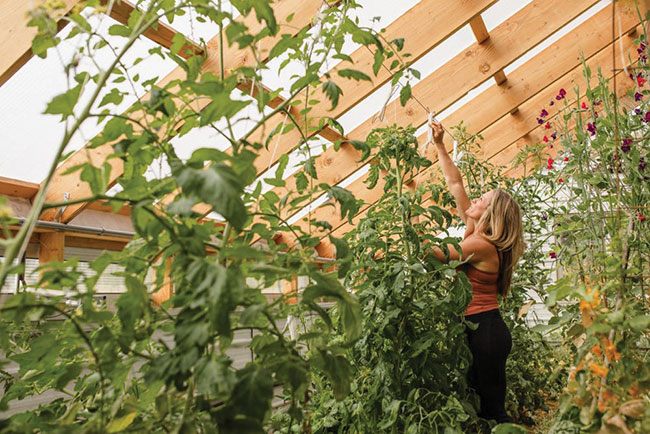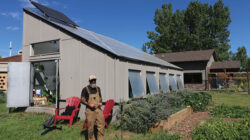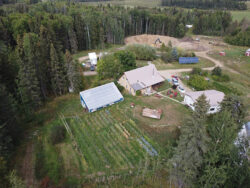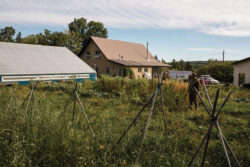
Features
The Permaculture greenhouse
What, when, where, who, why?
May 5, 2023 By John Dietz
 Verge Permaculture today is an internationally recognized, award-winning regenerative design, consulting and education centre with a team of 10 people.
Photos courtesy of Verge Permaculture.
Verge Permaculture today is an internationally recognized, award-winning regenerative design, consulting and education centre with a team of 10 people.
Photos courtesy of Verge Permaculture. Quick quiz: Give me a nine-word definition of permaculture. Now, apply that to greenhouses.
Answer 1: A form of agriculture which can be sustained indefinitely.
Answer 2: A philosophy of working with, rather than against, nature.
One day soon, Rob Avis hopes a new paradigm, permaculture, will emerge for the junction of energy and biology. He’s working on it with a team at his own greenhouse and woodlands. It’s a work in progress.
When he isn’t teaching or studying or consulting, the mechanical engineer is managing 160 acres about an hour south of Edmonton. He prefers to talk about where he’s going, rather than where he’s from, but claims a boyhood in Vancouver followed by a move to Alberta when his family decided to start a cheesecake factory.
“Actually, I’m from industrial food and from industrial energy. Now I teach about decentralized food production and decentralized energy systems,” Rob says.
Rob and his wife, Michelle, former oil and gas engineers, launched Verge Permaculture from their Calgary home in 2008. They converted the property into a living permaculture project. In 2019, they moved to the 160-acre wooded property in central Alberta (Westerose).
Verge Permaculture today is an internationally recognized, award-winning regenerative design, consulting and education centre with a team of 10 people. It offers online webinars, coaching, permaculture design certification, a YouTube channel, a property design and management program, even courses in greenhouse design and rainwater harvesting (Check out: www.vergepermaculture.ca).
Early in his engineering career, Rob says, “I became deeply troubled about energy depletion and how humanity was going to adapt to a low energy future.” That pursuit led him all to all sorts of places, and eventually to permaculture.
Today, Rob has a packed schedule of courses, workshops, and paid consulting time. Michelle’s focus is on the Verge greenhouse and garden, growing microgreens, sprouts, herbs, and veggies for the couple and their two young children.
First greenhouse
“As a mechanical engineer, one of my core interests is where thermal dynamics and biology come together,” Rob says. “Early in my transition to permaculture and recognizing that I lived in a cold climate (Calgary) with 100 frost-free days, it became clear that if I wanted to grow a bunch of my own food and help other people grow a bunch of their own food, that I had to get proficient at greenhouse growing.

Verge Permaculture offers online webinars, coaching, permaculture design certification, a YouTube channel, a property design and management program, and more.
“I started investigating different technologies. That got me interested in passive solar greenhouses, which use a fraction of the thermal energy to keep warm. They are designed around maximizing light collection while minimizing thermal energy loss. Basically, we glaze the south side and insulate the other sides.”
They started with a 200-sq.-ft. backyard greenhouse. It was able to easily supply a growing environment for three seasons, or roughly 250 days in a year. They wanted better.
They built Version 2 at Hull Services, a non-profit organization beside a school in southwest Calgary. It runs four seasons a year.
“They have figs, grapes, tomatoes, and peppers, all the conventional greenhouse crops. But then, they are also growing some Mediterranean crops as well. It’s been going at least five years, and it’s going great,” Rob says.
Version 3, another prototype, is at their farm. It covers 800 sq. ft., runs three seasons and has a fully functional geothermal heat storage system.

Version 3, another prototype, is at their farm. It covers 800 sq. ft., runs three seasons and has a fully functional geothermal heat storage system.
“It collects thermal energy all summer and fall and stores the energy underground. That energy is released in winter to keep the greenhouse from going below freezing. This could easily be scaled to any kind of commercial size. East and west, you can make it as big as you’d like,” Rob explains. “This is primarily for conventional greenhouse crops, like tomatoes, cucumbers, some lettuce, some kale. The primary goal for this one is just food production for our family, but also demonstration for our greenhouse business.”
Version 4 began construction in 2021 in Kamloops, B.C. It’s about the same size as Version 3 but far more complex. It is expected to go into operation in 2023.
The experimental design integrates three root cellars and a commercial kitchen with the greenhouse. Each root cellar will operate at a different temperature, using earth tube technology. Earth tubes are a passive technology, like a ventilation duct, that enable transfer of ground-source energy to heat, or cool, incoming air.
“From an energy perspective, it’s really important that we figure out how to keep our food cold and preserved for long periods of time without having to run high-energy intensity refrigeration systems,” Rob says.
In winter, fresh air that that may enter at -20C will be pre-warmed by the earth before it blows into the root cellars. Fresh vegetables in the cellar, like potatoes or carrots, need a steady supply of fresh air. Air through the earth tubes ensures that the storage stays cool while providing enough oxygen for humans to be safe.
“We want fresh air moving through that system, but we want the air to be tempered to the correct temperature, so that the food remains viable for a long period of time,” Rob says. “The waste air from the root cellars will blow into the greenhouse, providing a low-level heat as well as any decomposition gases to feed the greenhouse plants. In principle, the root cellar and greenhouse will work in symbiosis.”
In summer, of course, the system reverses. Hot summer air can be pushed through the earth tubes and cooled by the earth, becoming a healthier temperature when it enters the greenhouse.
Multiple other greenhouses have been built already using the prototypes developed by Rob and Michelle, and more are in discussion in the range of 1,000 sq. ft. to 3,000 sq. ft. “We’re moving toward Version 5 now, and we’re starting to explore pre-fabrication,” Rob adds.
Global perspective
“From a global perspective, the refrigeration issue is going to exceed heating energy globally within the next five years,” Rob predicted. “We’re collecting all the data on these greenhouses right now just to confirm that our thermodynamic models are correct. The goal is to scale these up to commercial size, multi-acre greenhouses.”

You can learn more about these projects at: www.vergepermaculture.ca.
Modern greenhouses are “energy hogs” compared to the permaculture-type greenhouses that Rob is developing.
“We can undercut the thermal energy consumption of conventional greenhouses by between 50 and 90 per cent,” he says.
On the thermal energy component, he is designing for 2030 and beyond, when heating costs with coal, natural gas or electricity will be far more, and when businesses will be desperate for ways to offset the carbon footprint.
“In places like Kamloops, where our $500,000 Version 4 greenhouse prototype is right now, that greenhouse will never need external energy for heat. That’s pretty substantial. We want to eliminate the majority of thermal energy, natural gas, coal, essentially, by moving the extra summer supply of thermal energy into a supply for the winter months,” he says. “Here’s the challenge that every business owner is facing if you build a greenhouse today: Canada is moving towards net neutral standards. If you build a building today that doesn’t meet the requirements of 2030, that you can’t afford to heat in 10 years, what are you going to do with it? Before building, businesses have to look at the life of the project and do a risk assessment about where energy and carbon prices are going in the next decade or two.”
Print this page